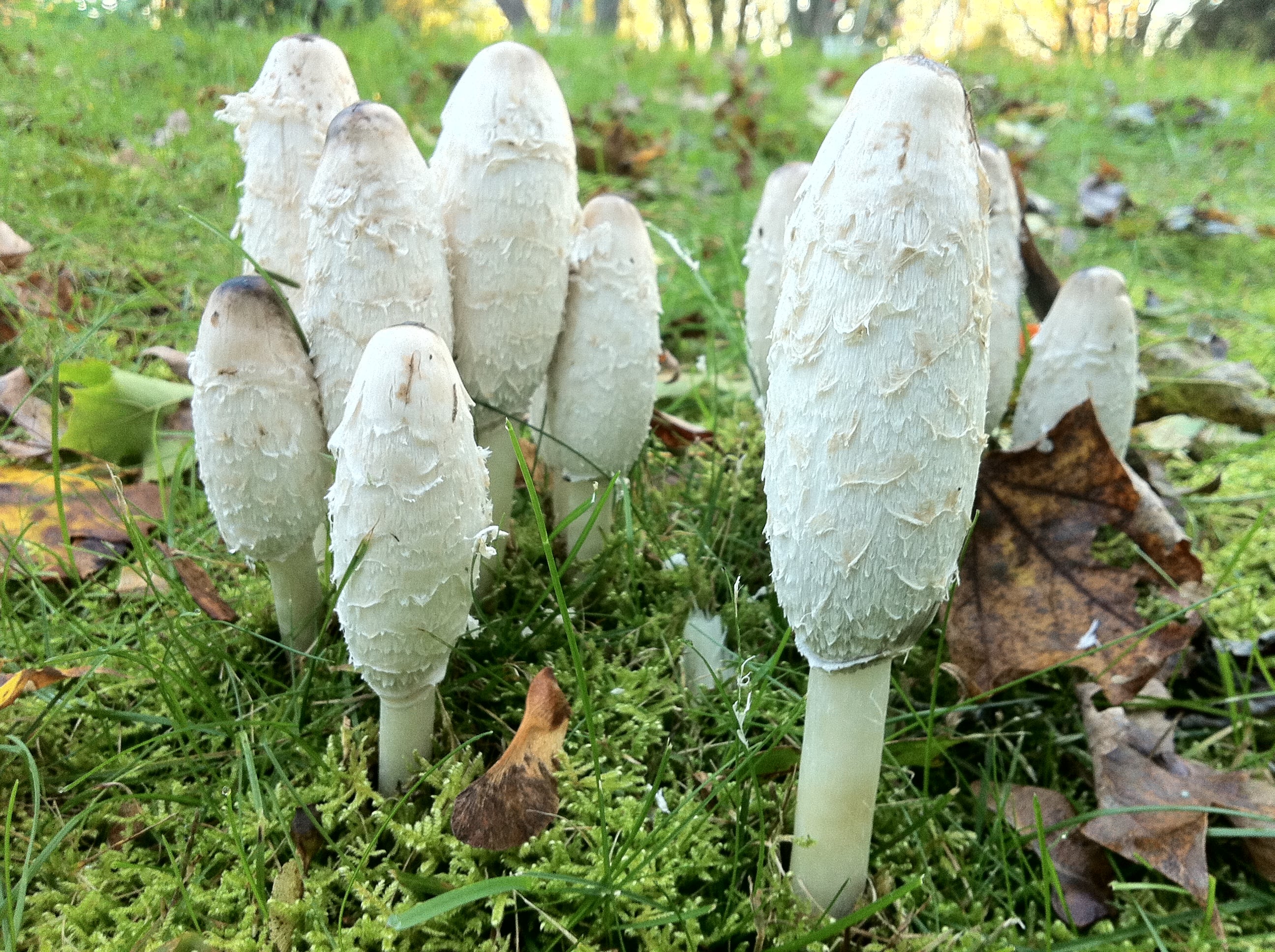Coprinus (Coprinus comatus, common dung beetle, shaggy-ink cap) is a very abundant fungus that prefers temperate, northern hemisphere regions. It can be found from summer to autumn and prefers open, moist places with soil that has plenty of nitrogen. It cantherefore be found in meadows, forest edges, gardens, manure fields, etc.
Coprinus belongs to the genus Coprinus, a genus comprising more than 100 species. DNA analysis has shown that these species belong to/are closely related to the Agaricaceae and Psathyrellaceae families. Coprinus comatus is a "true" member of the genus Coprinus. Coprinus has a recognizable, unmistakable appearance. The mushroom is about 10-37 cm tall. It has a cylindrical cap that is closed in the young mushroom and covers most of the leg. The young mushroom is pale, with scales on the cap that are light brown. However, within a few days there is a change. The mushroom takes on a pink colour that quickly turns to black and the mushroom secretes an ink-like liquid, giving it its English name. Basically, it looks like the old fungus is melting away and literally disappearing before our eyes.
Coprinus is an edible mushroom, but only when it is white, i.e. young, and the cap is closed. By the time it changes colour, it has become inedible. When consuming Coprinus, care must be taken not to spike it with alcohol. Coprinus contains the toxin coprin [N-(1-hydroxycyclopropyl)-L-glutamine], which is metabolised in the body to 1-aminocyclopropanol, similar to disulfiram, i.e. antabuse, which blocks the metabolism of ethanol, thus causing the so-called coprin syndrome. This is based on blocking aldehyde dehydrogenase, blocking the transformation of acetaldehyde to acetate, leading to the accumulation of acetaldehyde in the liver. Symptoms appear in 15-30 minutes after drinking alcohol on mushrooms, these are collapse states from dilation of blood vessels, flushing, impaired breathing, palpitations, tremors, diarrhea, vomiting, etc. The syndrome is not fatal, but can be dangerous in people with heart disease. The effect of Coprin lasts for a few hours, then subsides on its own. If the symptoms are severe and it is a cardiovascular problem, substances can be given to constrict the blood vessels and help the heart, e.g. noradrenaline.
Coprinus was described in 1780 by the Danish naturalist O. T. Müller, at that time it was classified as a mushroom and given the name Agaricus comatus. In 1797 Coprinus received its name, which it still has today. It was named Ch. H. Petersoon.

Composition of Coprinus:
Polysaccharides:
As with other vital mushrooms, Coprinus is a good source of carbohydrates, both polysaccharides and simple carbohydrates. Coprinus contains both non-absorbable polysaccharides, i.e. coarse fibre, which serves to feed the gut bacteria that contribute to our health, and absorbable polysaccharides.The latter have significant biological effects.This group includes mainly glucans. Coprinus is composed of both alpha and beta glucans, which predominate. Many studies have been written about the effect of beta glucans on humans, many of which can be found on the internet in publicly available sources. For example at www.cinksyherbar.cz
Inaddition topolysaccharides, disaccharides and pentasaccharides are also found in Coprin.
Water-soluble fucogalactan (CMP3) is also an important component of Coprin. This is an intracellular polysaccharide found mainly in fungal mycelia.
Amino acids and proteins:
In addition to polysaccharides, amino acids and proteins make up a large part of Coprin' s content. Coprinus contains a wide range of amino acids. Experiments have yielded more than 2000 mg of amino acids from a 100 g sample of the mushroom. These are substances that serve as building blocks for the formation of proteins, can be used to form carbohydrates, etc. Coprinus also contains essential amino acids that the body is unable to synthesise and must be supplied by food. These amino acids are listed in order of concentration Valine>Leucine>Lysine>Isoleucine>Threonine>Phenylalanine>Tryptophan>Methionine. Of the non-essential amino acids, glutamic acid is the most abundant, and there are also so-called non-standard amino acids such as gamma amino butyric acid (GABA), which also functions as a neurotransmitter in the brain, ornithine and ergothioneine. When comparing the mature mushroom and mycelium, there is much more lysine, glutamic acid, aspartate or phenylalanine in the mature mushroom. The mycelium is richer than the mature mushroom in methionine, arginine and tyrosine.
The complex proteins in Coprin are often enzymes, i.e. substances whose action results in the breakdown or synthesis of many substances, nutrient metabolism, etc. Coprinus contains enzymes that have fibrinolytic activity, i.e. they can break down the blood plug, the thrombus. Then there are enzymes that block angiotensin converting enzyme, so it acts similarly to ACE I drugs that are given to lower blood pressure.
However, it also contains enzymes that are capable of cleaving and breaking down many toxic compounds that are introduced into the soil by humans. These include lactase, which can break down phenols and aromatic amines. Peroxidase is also effective.
An important component of Coprin is also a glycan-binding protein, which has been designated the Y3 protein, which is composed of 130 amino acids. This shows toxicity against leukaemia cells.
We cannot fail to mention lectins, which are proteins capable of binding many carbohydrate components and of participating in the immunological response in the presence of bacteria and other pathogens.
Terpene compounds:
Coprinus also carries terpene compounds. Unique to it are sesquiterpenes such as the illudins C2 and C3 and compounds derived from them. Another sesquiterpene is coprinol, which is a derivative of cuparane and is considered an antibiotic, as are the illudines.
These substances, like other terpenes, are powerful antioxidants.
Phenols:
This group includes e.g. comatin, which affects cellular processes by reducing, improving glucose utilization by cells, leading to a reduction in glucose concentration outside the cells.
Minerals and vitamins:
The mineral and trace element content of Coprin depends in part on the environment in which it grows. Calcium, magnesium, sodium, potassium, iron, copper, zinc and manganese are abundant in Coprinus. Vitamins include vitamin D2, B vitamins and, to a lesser extent, vitamin C.
The substances that give Coprinus its flavour and aroma are:
These are alcohol compounds, ketones, amino acids, fatty acids, etc.
- 3-octanone
- 3-octanol
- 1-octen-3-ol
- 1-octanol
- 2-methyl-2-penten-4-olid
- 1-dodecanol
- Caprylic acid (fatty acid)
- 5'-GMP (cyclic guanosine monophosphate)
- Glutamic acid
- Butyric and isobutyric acid
Fatty acids:
There is no shortage of fatty acids in the composition of Coprin. It contains both unsaturated and saturated acids. Of the unsaturated, linoleic acid, oleic acid, and of the unsaturated, palmitic, stearic, myristic, etc. Polyunsaturated fatty acids make up 26% of the total fatty acids, monounsaturated 32.3% and saturated 20%.
Other substances:
There are a number of other compounds in Coprin, saponins, tannins, alkaloids, glycosides, etc.
 Vital mushrooms PRO (17)
Vital mushrooms PRO (17) MyTao Edition (14)
MyTao Edition (14) Vital Mushroom Extracts (25)
Vital Mushroom Extracts (25) Combination of mushrooms and herbs (18)
Combination of mushrooms and herbs (18) Traditional recipes (5)
Traditional recipes (5) BIO vital mushrooms powder (9)
BIO vital mushrooms powder (9) Syrups (12)
Syrups (12) Dried vital mushrooms (6)
Dried vital mushrooms (6) Honey products (5)
Honey products (5) Vitamins (4)
Vitamins (4) BIO green food (2)
BIO green food (2) Other (3)
Other (3)


